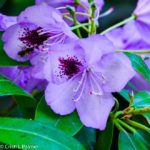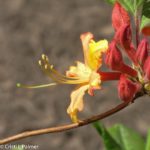This first appeared as “Spotlight on Ornamentals: A Thousand and One Arabian Rose Trees?” in the IR-4 Newsletter 46(4):4.
Plant Information
 Throughout the world there are more than 1,000 known species of Rhododendron, or “rose trees” as directly translated from ancient Greek. Commonly known in cultivation as azaleas, Rhododendron species are grouped with ericaceous plants (health, heather, cranberry and blueberry) and can be evergreen or deciduous. Rhododendrons are distributed worldwide in temperate to tropical climates. In addition to the large number of species, many inter-species hybrids and cultivars have been bred for improved bloom size, color, fragrance and foliage form.
Throughout the world there are more than 1,000 known species of Rhododendron, or “rose trees” as directly translated from ancient Greek. Commonly known in cultivation as azaleas, Rhododendron species are grouped with ericaceous plants (health, heather, cranberry and blueberry) and can be evergreen or deciduous. Rhododendrons are distributed worldwide in temperate to tropical climates. In addition to the large number of species, many inter-species hybrids and cultivars have been bred for improved bloom size, color, fragrance and foliage form.
Together, azaleas and rhododendrons are considered on of the top broadleaf evergreen horticulture crops in the U.S. with over $141 million wholesale value annually (USDA-NASS, Census of Agriculture 2009).
 In cultivation, there are three primary groups: evergreen rhododendrons, deciduous hybrid azaleas, and evergreen hybrid azaleas. Evergreen rhododendron species are understory plants in many eastern U.S. forests and are commonly used in landscape plantings in shady spots. (Figure 1). Both deciduous and evergreen azaleas may be place in shady areas but are often transplanted in more sunny locations, which can lead to stress and increased problems with lace bugs. A fourth group (Vireya Rhododendrons) are unusual in that they are epiphytic tender shrubs. Vireya rhododendrons originated in Southeast Asia in tropical regions, but they grow mostly in cool mountainous region as epiphytes on tall trees or low growing shrubs.
In cultivation, there are three primary groups: evergreen rhododendrons, deciduous hybrid azaleas, and evergreen hybrid azaleas. Evergreen rhododendron species are understory plants in many eastern U.S. forests and are commonly used in landscape plantings in shady spots. (Figure 1). Both deciduous and evergreen azaleas may be place in shady areas but are often transplanted in more sunny locations, which can lead to stress and increased problems with lace bugs. A fourth group (Vireya Rhododendrons) are unusual in that they are epiphytic tender shrubs. Vireya rhododendrons originated in Southeast Asia in tropical regions, but they grow mostly in cool mountainous region as epiphytes on tall trees or low growing shrubs.
Azaleas and rhododendrons are in the same genus which means they have fairly similar characteristics. However, along with other morphological and generic traits, they can be separated based on the number of stamens present in the flowers: azaleas have 5 stamens, and the rhododendrons have 10 stamens.
Main Disease and Pest Problems
 Azaleas and rhododendrons are prone to several disease and pests. Root pathogens include Phytophthora, Rhizoctonia, and foliar pathogens include Botrytis, Botryosphaeria, rusts and various fungi causing leaf spots. Pests include root-feeding insects such as the larval stages of black vine and strawberry weevils, Japanese and oriental beetles, and foliage or shoot feeding insects such as the adult stages of previous mentioned insects, lace bugs, aphids, scale and leaf miners. Ir-4 has sponsored efficacy research on some of these pathogens and pests. In particular, many experiments have been conducted to screen efficacy for various Phytophthora species including P. ramorum, a pathogen causing foliar blighting.
Azaleas and rhododendrons are prone to several disease and pests. Root pathogens include Phytophthora, Rhizoctonia, and foliar pathogens include Botrytis, Botryosphaeria, rusts and various fungi causing leaf spots. Pests include root-feeding insects such as the larval stages of black vine and strawberry weevils, Japanese and oriental beetles, and foliage or shoot feeding insects such as the adult stages of previous mentioned insects, lace bugs, aphids, scale and leaf miners. Ir-4 has sponsored efficacy research on some of these pathogens and pests. In particular, many experiments have been conducted to screen efficacy for various Phytophthora species including P. ramorum, a pathogen causing foliar blighting.
IR-4 Research
Weeds impact production of azaleas and rhododendron pots. Crop safety studies using over the top or directed herbicide applications are necessary for growers to know which products to use during dormant periods or during periods of active growth. Crop safety studies have been conducted with 15 fungicides. 61 herbicides and 10 insecticides. In addition, IR-4 has sponsored research on Rhododendron species with plant growth regulators to increase plant branching. Products containing 6-BA, or cyclanalide, exhibited variable impact from decreased to increased branching and products containing GA4+7 had no impact. In other words, some additional work is needed to determine best rates and/or timing to foster improved branching characteristics with different species and cultivars.
Rhododendron species have been well-studied crops though IR-4 due to their popularity over the years. As priority projects shift to different pathogens and pests, we will continue to work to develop efficacy and crop safety for relevant problems.
Rhododendron Growing Tips From Gardening Know How
The rhododendron bush is an attractive, blooming specimen in many landscapes and it fairly low maintenance when planted properly/ Growing rhododendron successfully requires the proper planting spot for the rhododendron bush. Proper soil preparation is also necessary for the health of this acid loving plant. Soil preparation is best accomplished in autumn before planting the rhododendron in spring. When to plant the rhododendron will depend on the USDA zone in which is grows. Growing rhododendron is an exacting task, but with the right soil and location, the rhododendron bush will provide an optimum performance. Unlike many blooming plants, rhododendron does not like full morning sun in winter and does best when planted in dappled shade on the north side of a building. Growing rhododendrons are happiest in a location protected from the wind and not under eves of a building.
When to Plant Rhododendron
Plant the rhododendron bush in spring when danger of frost has passed. Plant the bush high in properly prepared soil, as soggy and waterlogged roots are the main cause of plant failure in the landscape.
The rhododendron bush will likely be purchased as a containerized plant or a balled and burlapped specimen. The root ball should be soaked prior to planting. Moisture in required for proper rhododendron care. Place the plant in a tub or bucket for a brief soaking, until air bubbles disappear. Plant the rhododendron bush so that its crown is at the same level as in the pot.
Soil Preparation for Planting Rhododendrons
Correct soil pH for the growing rhododendron bush is crucial. between 4.5 and 5.5 on the pH scale is appropriate. A soil test is the best way to determine the pH of the soil and make amendments. Aluminum sulfate should be avoided when amending beds for growing rhododendrons; agriculture sulfur is preferred, as the aluminum may be harmful to the growing rhododendron.
The rhododendron bush is best planted in groupings in prepared beds as opposed to individual planting holes. Caring for rhododendrons will be simpler if they are planted in moisture retaining but well-draining loamy fertile soil with the proper pH. A 50% ratio of organic matter is encouraged as a soil amendment, as it provides aeration and drainage and allows the rhododendron bush to set higher
Caring for Rhododendrons
Once properly located in the planting beds, water thoroughly and cover with an organic mulch which will break down to supply nutrients as it decomposes. A pine bark covering applied at 2 inches is thought to inhibit fungi that causes root rot. Do not mulch with peat moss, as it is difficult to re wet after it has dried out. Proper mulching will decrease the need for future rhododendron care.
Rhododendron care includes a yearly fertilization which is best applied in fall, following a hard freeze of in early spring. Use a fertilizer for acid loving plants, such as organic cottonseed meal. The organic material you have worked into the soil previously will break down to provide some of the necessary nutrients.
Consistently moist soil is needed for proper rhododendron care, but too much water creates problems for the growing rhododendron. When leaves curl and twist, this indicates that water is needed immediately. The rhododendron bush should not be allowed to go though the stress of wilting. Shade-loving annuals, such as impatiens, may be planted as a companion to the rhododendron to indicate when water is needed.
Growing healthy and long-blooming rhododendrons starts with properly amended soil and planting in the correct location. These steps ensure minimal effort when caring for rhododendrons. Once sited properly, the rhododendron needs only adequate watering, pruning and deadheading of the flowers to encourage their abundant return.
Sources Cited
https://www.theatlantic.com/business/archive/2016/06/orchid-grower/487940/
http://www.proflowers.com/blog/the-history-meaning-of-the-orchid-5-surprising-facts
http://www.aos.org/orchids/orchid-pests-diseases.aspx
http://www.wikipedia.com
http://www.herbs2000.com/flowers/o_history.htm
http://www.orchid.org.uk/orchidstories.htm


